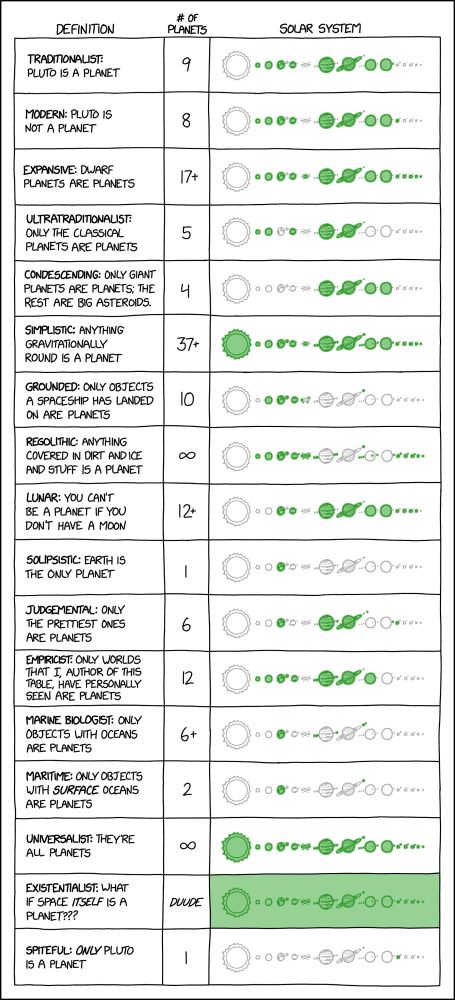
Planet Definitions xkcd.com/3063
14.03.2025 16:07 — 👍 10007 🔁 1734 💬 224 📌 165@smmiko.bsky.social

Planet Definitions xkcd.com/3063
14.03.2025 16:07 — 👍 10007 🔁 1734 💬 224 📌 165
Two observations of a portion of the galaxy NGC 628 are split diagonally, with Webb’s observations at top left and Hubble’s at bottom right. The galaxy’s core is roughly centered and the galaxy’s arms appear to rotate counterclockwise. The spiraling filamentary structure looks somewhat like a cross section of a nautilus shell. In Webb’s image, the spiny spiral arms are composed of many filaments in shades of orange, with prominent dark gray or black “bubbles,” and there is a blue haze near the core. In Hubble’s image, the spiral arms are a mix of bright blue star clusters, pink star forming areas and dark brown dust lanes, and the core is a pale yellow.

Two observations of the galaxy NGC 1300 are split diagonally, with Webb’s observations at top left and Hubble’s at bottom right. The galaxy’s core is centered, connected to a prominent diagonal bar structure. The galaxy’s two distinct spiral arms begin at the end of the bar and rotate counterclockwise. Together, the arm and bars form a backward S shape. In Webb’s image, the bar and spiral arms are composed of many filaments in shades of orange, and are anchored by its central region, which is circular and light yellow. In Hubble’s image, the spiral arms are a mix of bright blue star cluster and dark brown dust lanes, and the bar and core are a pale yellow.

Two observations of the galaxy NGC 1512 are split diagonally, with Webb’s observations at top left and Hubble’s at bottom right. The galaxy’s core is centered and circular, with two prominent dust lanes crossing the large diagonal bar structure appearing toward the top left and bottom right. The central bar is blue at top, looking like a gap until a closer examination shows it feeds a larger, oval shape that looks braided with many spiral arms. In Webb’s image, the spiral arms are composed of many filaments in shades of orange. In Hubble’s image the bar is a light pinkish-brown and the spiral arms are a mix of bright blue star clusters and dark brown dust lanes.

Two observations of the galaxy NGC 3351 are split diagonally, with Hubble’s observations at top left and Webb’s at bottom right. The galaxy’s core is centered and the galaxy’s arms rotate clockwise and form a distinct outer ring. In Hubble’s image, the galaxy’s roughly horizontal bar structure is a pale yellow and the spiral arms are a mix of bright blue star clusters and dark brown dust lanes that form half of the large circular ring. In Webb’s image, the spiral arms form the other half of the large ring, which is made of many filaments in shades of orange. They are anchored by its central region, a hazy blue bar, connected to the central core. The core has a small orange oval around a more circular light yellow oval, with a blue dot at its center.
these webb/hubble images are truly incredible. the fact that we can see the universe in different wavelengths of light and spot so many unseen details is mind-blowing 🌌
09.02.2025 03:23 — 👍 3916 🔁 527 💬 56 📌 27 04.02.2025 23:43 — 👍 14570 🔁 2226 💬 129 📌 119
04.02.2025 23:43 — 👍 14570 🔁 2226 💬 129 📌 119

A warm Imbolc in this time of transition.
“Let the rain kiss you. Let the rain beat upon your head with silver liquid drops. Let the rain sing you a lullaby.” ― Langston Hughes

This image shows the Ring Nebula (M57), a planetary nebula, that is the glowing remains of a sun-like star appearing as a giant cosmic flower in shades of red predominantly. In the image, the amazing outer material surrounding the ring was ejected from the star during the early stages of nebula formation, the beginning of the end of its glorious existence.
🧵 🧪 🔭
1/
This fantastic image features the Ring Nebula (M57), a planetary nebula, that is the glowing remains of a sun-like star appearing as a giant cosmic flower.
Source➡️ apod.nasa.gov/apod/ap21081...
Approximately 2,500 ly away toward the constellation Lyra, M57 is illuminated by

A roughly oval emission space nebula, sort of cut in a larger and smaller section, in SHO “Hubble” palette; embedded in a sea of stars.
I secretly put out a trap when space photons least suspected it. You won’t believe what happened next!
The Soul Nebula, about 7,500 light years in the constellation Cassiopeia.
🔭🧪 #astrophotography

“Be patient toward all that is unsolved in your heart and try to love the questions themselves, like locked rooms and like books that are now written in a very foreign tongue. Do not now seek the answers, which cannot be given you because you would not be able to live them. And the point is, to live everything. Live the questions now. Perhaps you will then gradually, without noticing it, live along some distant day into the answer.”
.
"And the point is, to live everything..."
—Rainer Maria Rilke
#poetry #poem #poems

Staying up late was worth it to capture the Milky Way's beauty.
#Astrophotography